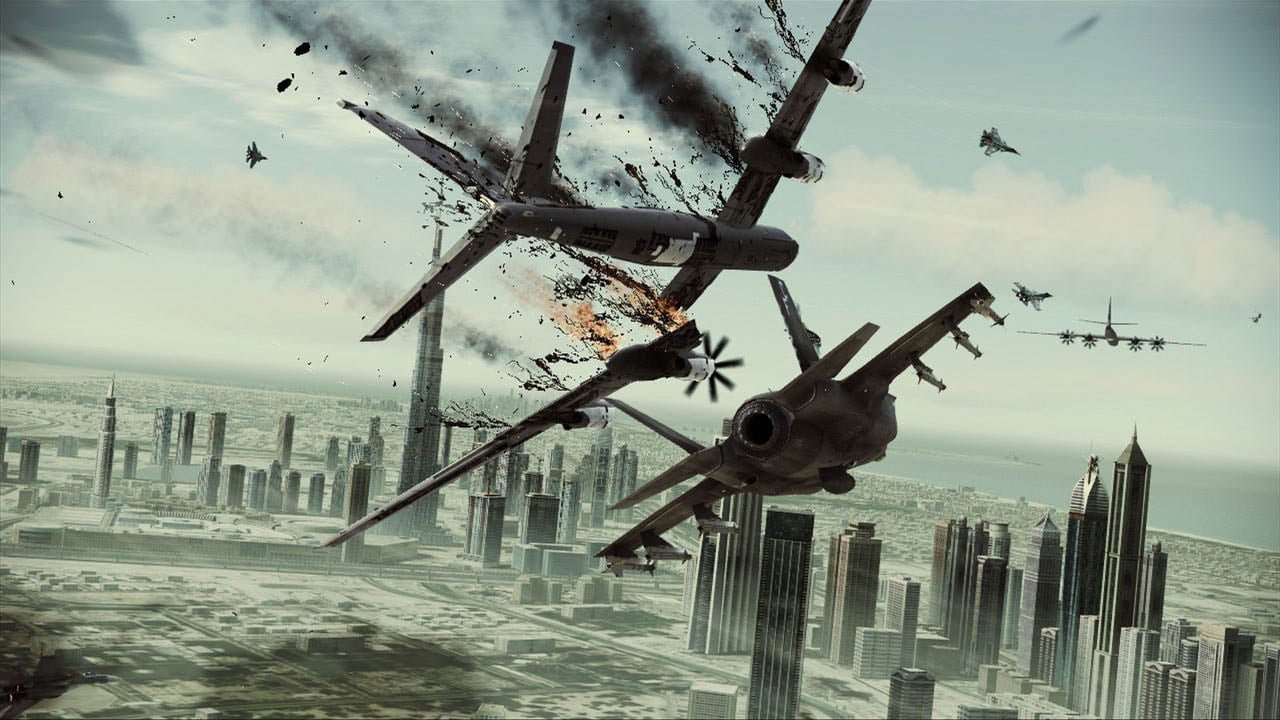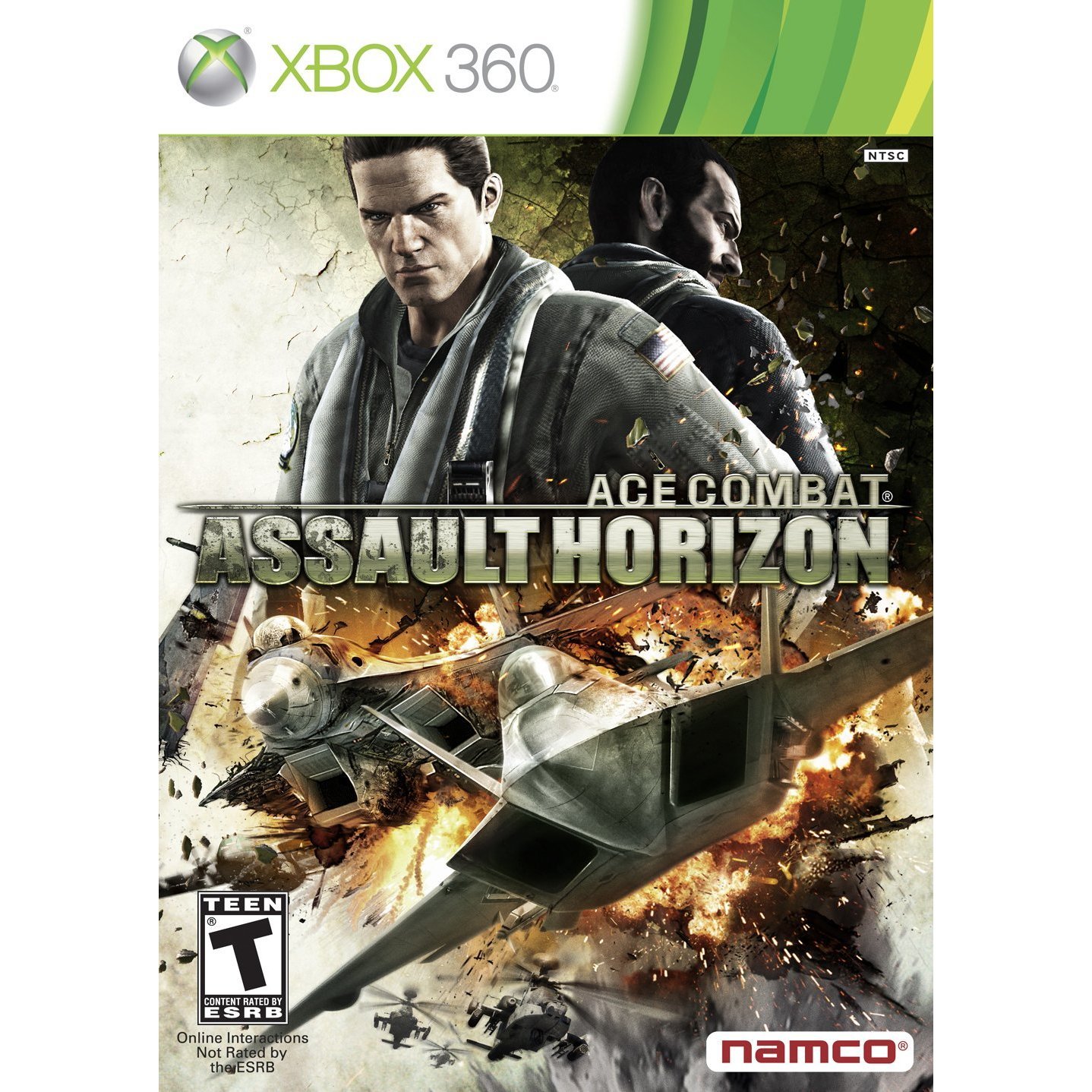It’s Time To Buzz A Tower
The Ace Combat series has always walked on a tightrope, balancing a fast paced, more arcade-y, instant-gratification sensibility to aerial combat, with a more simulated approach. It’s always erred more on the side of the arcade, but at the same time, tried to maintain some of the spirit of an aerial dogfight with contemporary fighters. Ace Combat: Assault Horizon is the first of the series to finally debut as a multi-platform title (Ace Combat 6: Fires of Liberation was an Xbox 360 exclusive in 2007) and it brings with it a surprising number of changes that mostly succeed at changing the old formula somewhat while still keeping the foundation intact. This isn’t the Ace Combat that fans are familiar with, but it might be the Ace Combat that brings some new players into the fold.
The Data On the MiG is Inaccurate
For the first time in years, Ace Combat: Assault Horizon abandons the “Strangereal” setting of previous games, a fictional, alternate Earth with its own nations, history and military forces that just happened to use American and Russian combat aircraft. Instead, thanks in part to the writing contribution of military novelist Jim DeFelice, the game firmly treads the Earth we know, with a group of American pilots taking on a conspiracy that conveniently pits them against top of the line Russian combat planes. The missions take place all over the world, from Africa to the Middle East to North America and Europe. The story itself is serviceable, though, perhaps because of its dealing with real world cultures, it doesn’t delve as deeply into the tragic futility of war and its human cost as Ace Combat 4: Shattered Skies did, nor does it develop its characters or examine themes of nationalism the way Ace Combat 5: The Unsung War did. Instead we get a very straightforward yarn about super weapons, betrayals and some pretty impressive mobilization of combined arms in some very familiar locales. Purists may lose heart over the fact that the new setting seems to have come at the cost of a deeper story, but the observant will note that this is not a numbered iteration of the series, so there might be more Strangereal stories on the way.
Getting into the presentation, we see once again that aerial combat games benefit a lot from the current generation of consoles. The real world setting of AC:AH means that the Project Aces team was able to use more detailed satellite imagery to create their battlefields. For anyone familiar with the locales, the result is startling. Even far-flung cities like Dubai in the Middle East are accounted for with contemporary landmarks like the ridiculous Palm Jumeirah artificial island or the Burj Al Arab hotel intact and part of the landscape. When played normally, AC: AH is a good looking game with a solid frame rate that keeps up with the player. The only seams in the crack start to show during those moments when players get a little too close to the ground. Cities, deserts and stormy shores look fine at high altitudes, but betray their flat textures when you go in low. Lighting on the other hand benefits from the HD power of the consoles with little touches like flying into the sun creating the blinding effect you’d expect. The same goes for explosions and debris, with the slow-motion destruction of enemy planes making a big impression. There are definitely some weaknesses in the visuals, but they’re only noticeable when you stop and take the time to look for them. Usually the combat is so fast and furious you won’t. It needs to be mentioned that the planes, unsurprisingly, are the real stars of the show and look absolutely gorgeous. The attention to detail makes it obvious that the Project Aces team is utterly devoted to military war machines.
Sound is a feast for people with the right set up. As you’d expect from an aerial combat game, this is the sort of experience that translates well to a multi-speaker set up with directional sound of missiles, planes, explosions and your own gunfire erupting everywhere. It doesn’t quite have the same punch as an FPS, Namco’s not really working over the subwoofer as aggressively as they could, but it manages to keep things busy with a robust range of explosions, engines and other assorted sound effects. The soundtrack is the same mix of orchestra and rock that the Ace Combat series is known for, being at turns majestic and then adrenaline fuelled depending on the context. The voice acting, like the story, is serviceable many actors faking many accents from Russian to French.
You Can Be My Wingman Anytime
In shedding the fictional world of Strangereal with its self-made history and politics, Namco is probably hoping to attract the Western crowd, and they do it in the most obvious way possible. They’ve incorporated FPS elements into the Ace Combat series and its contemporary setting makes the game legitimately about Modern Warfare and answering the Call of Duty.
There are two major changes made to the series. The first, a la Call of Duty: Modern Warfare, is that the player now jumps into the heads of multiple characters, in this case, a fighter pilot—the main character—a bomber pilot, an AH-64 Apache combat chopper pilot, and a door gunner. While the meat and potatoes of AC: AH is still unquestionably the aerial dog-fighting with shiny, jet-fuelled machines of war, there are additional missions—much like Catwoman in Batman: Arkham City—that act as palette cleansers to add a little variety and shake up the pace. Players will find out what it’s like be in control of an AC-130 and rain down bullets in the 40 mm up to 120 mm variety, pilot B1 and B2 stealth bombers, sit at the door of a UH-60 Blackhawk and fire from a turret gun and finally, engage Hinds in a combat chopper of your own. All of this adds much variety to a game that was traditionally about one character, flying a variety of planes. The bomber and door gunner sequences are largely on rails, but add a different flavour to the game that works in small amounts. The AH-64 sequences are interesting, but feel a little awkward in terms of controls. Namco compensates by generously using an auto-lock on feature so players can concentrate on navigation, but the AH-64 sequences never seem to gel as smoothly into the main game as the other elements.
The other, even larger change is the addition of two new FPS modes to aerial combat known as Dog Fight Mode and Air Strike Mode for ground attacks. DFM is engaged when players get within spitting distance of enemy planes, hitting the bottom shoulder buttons of the controller in order to get behind them and try to keep a targeting reticle on fleeing target to get more powerful missile locks and keep the gunfire pouring. ASM is engaged by flying through an indicator to put players in an on-rails “bombing mode” to better take out surface targets. Both of these modes work in both single and multi-player modes. DFM in particular adds a new intensity to combat that has never been present in the series. The Ace Combat, for series veterans, has traditionally always devolved into turning contests between opponents to see who could make a tighter circle to get behind an enemy and finally launch missiles at an optimal angle they can’t jink away from. DFM eliminates the more sterile aspect of combat, allowing both attacker and defender a more active role—even making it possible to counter evasively and reverse the situation. It may feel more “FPS-y” but it also makes things more exciting.
Unfortunately these new, drastic changes come at significant cost, and that’s largely the pacing and streamlining of other elements. Ace Combat: Assault Horizon is a very short game compared to its predecessors. The single-player can be wrapped up in 6-8 hours, with very few missions compared to monsters like Ace Combat 5: The Unsung War. What missions are included feel overly long, and pad out their duration by simply throwing wave after wave at the player. Compare this with the variety of missions in past games that had players doing everything from escort, to protecting a rocket launch to making a Death Star style trench run, and the AC: AH solution of “Just throw more planes at ‘em every few minutes” feels a bit cheap. The game also loses some of the more complex, interesting touches of past games, such as gaining money from missions in order to purchases new planes. Smaller touches from past games such as data recordings of your flight pattern so you can see the exact path you took during combat are also absent. All the frills have been stripped out, instead focusing players on the present mission with a limited number of choices as to how to go about executing the mission. Even the Ace Combat 6 feature of building up meters for super attacks or extra defence has been shed in favour of leaner combat. While the combat of Ace Combat: Assault Horizon is fun and rewarding, it could have only benefited from more mission variety and a few more frills.
The short single player campaign is complemented with a simple but robust multi-player. An online co-op mode is available that strips out the AI pilots of the campaign and puts up to three players together in campaign missions. It’s terrifying to see just how quickly the missions can be accomplished when the ineffectual AI is stripped out and additional human pilots are added to the mix. On the competitive side, there are Conquest, Domination and Death Match modes that borrow the perks system from the COD series and allow players to pick skills which benefit themselves as well as three additional players in their assigned squad. Once again, the Dog Fight Mode surprises in online as players can engage the same enemies which—with teamwork—can prove incredibly devastating to enemy forces.
While the online component isn’t full of extras, features and modes the way other games are, the inherent mix of numerous vehicles from specialist fighters to multi-role planes and even bombers makes for a complex web of potential strategies. Classic combat moments with heavy bombers making a run while fighters fly escort quickly turn into the kind of frenzied combat you’d imagine when 16 players are in the air firing guns and missiles at each other. There’s a surprising amount of fun and longevity to be hand in the multi-player component of AC: AH, and, as with the campaign, there’s a lot of potential here if they can continue to iterate on it.
Ultimately, Ace Combat: Assault Horizon is a game that can potentially divide its audience. On the one hand, the purists of the more traditional Ace Combat games will balk at the dramatic changes made to the series. On the other hand, players that have fantasized about Maverick from Top Gun who just couldn’t get into overwrought fiction of Namco’s “Strangereal” world will find the more grounded setting and FPS elements a bigger draw. Both audiences however, can enjoy the surprisingly solid foundation of the game’s multi-player. In many ways, AC: AH feels like a cornerstone in a new chapter for the series. Some promising new concepts have been laid out here, which are hurt by pacing issues and some oversimplification, but more polish and refinement can really make these ideas shine. What is here is fun, frantic and a good enough fix for fans of aerial combat that they should consider picking this up. It’s likely to get overshadowed by all the high profile titles out in this last quarter of the year, which is a shame since it manages to rise above its small problems for some brilliant flashes of gameplay.






